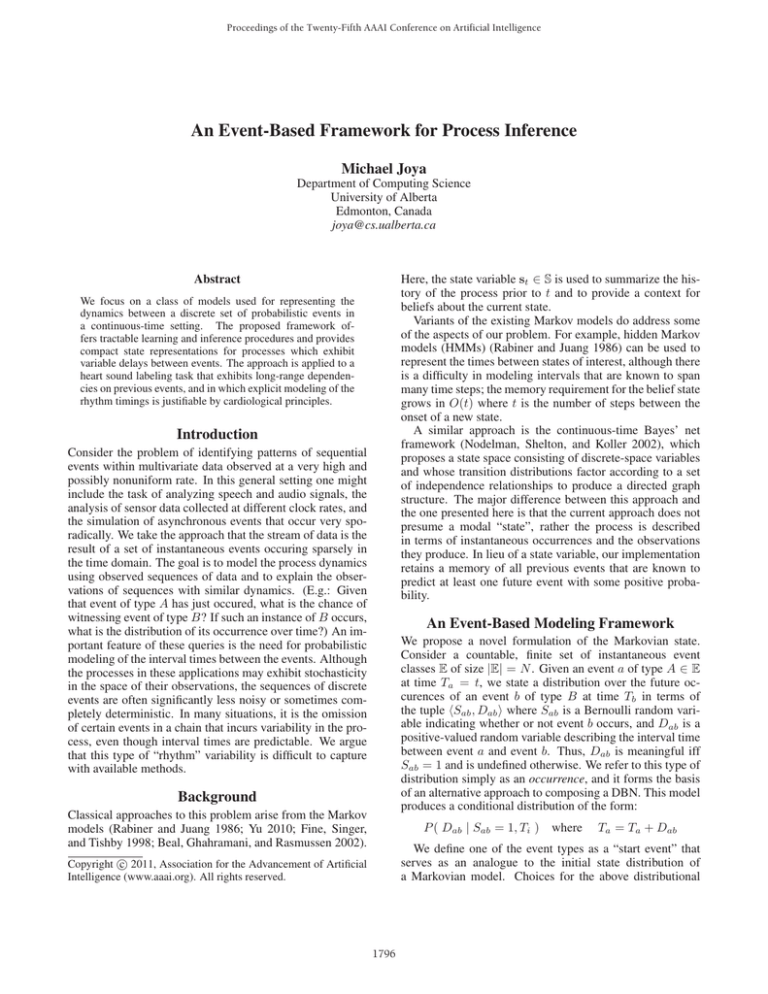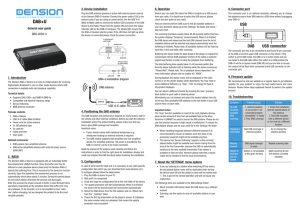
Proceedings of the Twenty-Fifth AAAI Conference on Artificial Intelligence
An Event-Based Framework for Process Inference
Michael Joya
Department of Computing Science
University of Alberta
Edmonton, Canada
joya@cs.ualberta.ca
Here, the state variable st ∈ S is used to summarize the history of the process prior to t and to provide a context for
beliefs about the current state.
Variants of the existing Markov models do address some
of the aspects of our problem. For example, hidden Markov
models (HMMs) (Rabiner and Juang 1986) can be used to
represent the times between states of interest, although there
is a difficulty in modeling intervals that are known to span
many time steps; the memory requirement for the belief state
grows in O(t) where t is the number of steps between the
onset of a new state.
A similar approach is the continuous-time Bayes’ net
framework (Nodelman, Shelton, and Koller 2002), which
proposes a state space consisting of discrete-space variables
and whose transition distributions factor according to a set
of independence relationships to produce a directed graph
structure. The major difference between this approach and
the one presented here is that the current approach does not
presume a modal “state”, rather the process is described
in terms of instantaneous occurrences and the observations
they produce. In lieu of a state variable, our implementation
retains a memory of all previous events that are known to
predict at least one future event with some positive probability.
Abstract
We focus on a class of models used for representing the
dynamics between a discrete set of probabilistic events in
a continuous-time setting. The proposed framework offers tractable learning and inference procedures and provides
compact state representations for processes which exhibit
variable delays between events. The approach is applied to a
heart sound labeling task that exhibits long-range dependencies on previous events, and in which explicit modeling of the
rhythm timings is justifiable by cardiological principles.
Introduction
Consider the problem of identifying patterns of sequential
events within multivariate data observed at a very high and
possibly nonuniform rate. In this general setting one might
include the task of analyzing speech and audio signals, the
analysis of sensor data collected at different clock rates, and
the simulation of asynchronous events that occur very sporadically. We take the approach that the stream of data is the
result of a set of instantaneous events occuring sparsely in
the time domain. The goal is to model the process dynamics
using observed sequences of data and to explain the observations of sequences with similar dynamics. (E.g.: Given
that event of type A has just occured, what is the chance of
witnessing event of type B? If such an instance of B occurs,
what is the distribution of its occurrence over time?) An important feature of these queries is the need for probabilistic
modeling of the interval times between the events. Although
the processes in these applications may exhibit stochasticity
in the space of their observations, the sequences of discrete
events are often significantly less noisy or sometimes completely deterministic. In many situations, it is the omission
of certain events in a chain that incurs variability in the process, even though interval times are predictable. We argue
that this type of “rhythm” variability is difficult to capture
with available methods.
An Event-Based Modeling Framework
We propose a novel formulation of the Markovian state.
Consider a countable, finite set of instantaneous event
classes E of size |E| = N . Given an event a of type A ∈ E
at time Ta = t, we state a distribution over the future occurences of an event b of type B at time Tb in terms of
the tuple Sab , Dab where Sab is a Bernoulli random variable indicating whether or not event b occurs, and Dab is a
positive-valued random variable describing the interval time
between event a and event b. Thus, Dab is meaningful iff
Sab = 1 and is undefined otherwise. We refer to this type of
distribution simply as an occurrence, and it forms the basis
of an alternative approach to composing a DBN. This model
produces a conditional distribution of the form:
Background
Classical approaches to this problem arise from the Markov
models (Rabiner and Juang 1986; Yu 2010; Fine, Singer,
and Tishby 1998; Beal, Ghahramani, and Rasmussen 2002).
P ( Dab | Sab = 1, Ti )
where
Ta = Ta + Dab
We define one of the event types as a “start event” that
serves as an analogue to the initial state distribution of
a Markovian model. Choices for the above distributional
c 2011, Association for the Advancement of Artificial
Copyright Intelligence (www.aaai.org). All rights reserved.
1796
variance and a low mean time while the alternate S2 → S1
transition time is less predictable.
Rhythmic properties of the problem domain can thus be
used to improve inference about the exact timing of S1/S2
events in new patients once population parameters for these
transitions have been learned. Such properties would have
been quite difficult to model explicitly with conventional
Markovian models.
model can include any density function defined over the
positive real numbers. In our present application, we use
the log-normal distribution with parameters μDij , σDij .
(However, the option to use a nonparameteric density estimate is available, see (Parzen 1962)). The events provide a generational model that produce the observed data
X(t) ∈ RM according to the distribution:
P ( X(t) | Ta = t, θA )
Future Work
Here, θi are the parameters of a linear observational model
X(t+k) = θi (k)·I{Ti =t} where k ranges over some positive
and measurable time span and describes the progression of
the event in the observation space.
Given an observed training data sequence X(t) and a set
of labeled event instances at sparse points in the time sequence, we can obtain a maximum likelihood estimator for
the parameters of the observation model and for the interval
times Dab via convex optimization.
Additionally, we can obtain population- and singlesample estimators for the interval times for situations involving multiple sequences of data.
With known parameters θ̂ML for the observational model,
it is possible to attain a density model for event classes over
all points in time. Obtaining precise estimates of the times
of event instances can be achieved using dynamic programming approaches.
We would like to extend our framework by showing that
short, reliable sequences of events can be treated as a
“macro-event” and that these larger events can be treated using the same framework to produce hierarchical models of
sequence data. The motivation for this work is to determine
whether it is possible to use the distributional parameters of
the transition times to aid in the learning of multiscale model
structure. We will therefore examine other application domains for which the input sequence exhibits clear rhythmic
patterns at several time scales. Such applications may include speech recognition, weather data, stock market data,
and the analysis and generation of musical scores.
References
Beal, M.; Ghahramani, Z.; and Rasmussen, C. 2002. The
infinite hidden markov model. Advances in Neural Information Processing Systems 1:577–584.
Fine, S.; Singer, Y.; and Tishby, N. 1998. The hierarchical
hidden markov model: Analysis and applications. Machine
learning 32(1):41–62.
Kudriavtsev, V.; Polyshchuk, V.; and Roy, D. 2007. Heart
energy signature spectrogram for cardiovascular diagnosis.
Biomedical engineering online 6(1):16.
Nodelman, U.; Shelton, C.; and Koller, D. 2002. Continuous
time bayesian networks. In Proceedings of the Eighteenth
Conference on Uncertainty in Artificial Intelligence, 378–
387. Citeseer.
Parzen, E. 1962. On estimation of a probability density
function and mode. The Annals of Mathematical Statistics
33(3):1065–1076.
Rabiner, L., and Juang, B. 1986. An introduction to hidden
markov models. IEEE ASSp Mag. 3(1):4–16.
Yu, S. 2010. Hidden semi-markov models. Artificial Intelligence 174(2):215–243.
Application: Heart Sound Identification
Our framework is applied to the task of identifying the two
primary heartbeat sounds, known in cardiological literature
as S1 and S2, or coloquially as the “lub-dub” sound. The
data consist of 20-second long samples of patient data collected from 25 patients. Only 10 of these patients are labeled with known S1 and S2 beats. The task is to identify
the precise instants at which the S1 and S2 beats occur in
the remaining 15 patients, and to label these points in the
sequence.
The waveform signal data for each patient are converted to their pseudo Wigner-Ville distribution (Kudriavtsev, Polyshchuk, and Roy 2007) to produce a spectrogram in
the joint time and frequency space. The interpolated spectrogram is then used as the multivariate observations X(t).
Using the maximum likelihood estimation procedures described above, we obtain both population and subject parameters for the observational model and for the transition
time distributions between the two event classes, i.e.: for
S1 → S2 and for S2 → S1.
It is notable that although both the S1 and the S2 beats
produce very similar “signatures” in the observational space,
they are relatively easier to identify using interval distributions unique to each patient. These rhythms are represented by subject parameters of the log-normal distribution
μDij , σDij that is used to model the transition times between the beats. For example, it is understood that the
complete cardiac cycle event, once initiated, will proceed
to completion reliably using a timing mechanism that is intrinsic to the nerve networks surrounding the heart. Within
a single patient, the S1 → S2 transition time exhibits a low
1797








